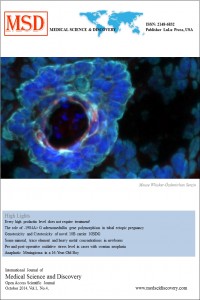Abstract
Hyperprolactinemia is a condition of elevated prolactin levels in blood. Pathological hyperprolactinemi presents as oligomenorrhea, amenorrhea, galactorrhea, decreased libido, infertility, and decreased bone mass. The prevalence of hyperprolactinemia ranges from 0.4% in general adult population to as high as 9-17% in women with reproductive diseases [1]. Hyperprolactinemia is usually defined as fasting levels of above 25 ng/ml in women at least 2 hours after waking up [2]. Unless the prolactin levels are markedly elevated, measurement of prolactin should be repeated before defining the patient as hyperprolactinemic. One normal value should be accepted as normal, other raised one should be disregarded. The conditions such as non-fasting sample, excessive exercise, history of drug intake, chest wall surgery or trauma, renal disease, cirrhosis can raise prolactin levels. If prolactin level is below 50 ng/ml, these situations should be excluded. The condition, known as macroprolactinemia, which is elevated prolactin levels but lack of clinical symptoms is due to the big variants of prolactin molecule (macroprolactin) which have poor or no biological effect and do not require any treatment [3]. Macroprolactin is mostly a complex of PRL with immunoglobulin G, especially anti-prolactin autoantibodies. Macroprolactinemia, rise of macroprolactin level, is found in 10-25% of women with hyperprolactinemia. Hyperprolactinemia mostly existed in macroprolactinemic patients are due to the retarded clearance of autoantibody-bound prolactin. Currently, polyethylene-glycol- (PEG) precipitation method is a gold standard for the diagnosis of macroprolactinemia (4). As a result, macroprolactinemia should be considered in normally ovulating women who have high prolactin levels. Neither treatments nor further investigations are recommended if free PRL concentrations after precipitating macroprolactin with PEG are normal. We know that macroprolactin has poor or no biological activity and pregnancy is even possible without any treatment for macroprolactinemia
Keywords
References
- 1. McBride CM, Hester JP. The problem of splenectomy in a leukemic patient population. Southern medical journal. 1976;69(6):715-8.
- 2. Halbreich U, Kinon BJ, Gilmore JA, Kahn LS. Elevated prolactin levels in patients with schizophrenia: mechanisms and related adverse effects. Psychoneuroendocrinology. 2003;28 Suppl 1:53-67.
- 3. Freeman ME, Kanyicska B, Lerant A, Nagy G. Prolactin: structure, function, and regulation of secretion. Physiological reviews. 2000;80(4):1523-631.
- 4. Shimatsu A, Hattori N. Macroprolactinemia: diagnostic, clinical, and pathogenic significance. Clinical & developmental immunology. 2012;2012:167132.
Abstract
References
- 1. McBride CM, Hester JP. The problem of splenectomy in a leukemic patient population. Southern medical journal. 1976;69(6):715-8.
- 2. Halbreich U, Kinon BJ, Gilmore JA, Kahn LS. Elevated prolactin levels in patients with schizophrenia: mechanisms and related adverse effects. Psychoneuroendocrinology. 2003;28 Suppl 1:53-67.
- 3. Freeman ME, Kanyicska B, Lerant A, Nagy G. Prolactin: structure, function, and regulation of secretion. Physiological reviews. 2000;80(4):1523-631.
- 4. Shimatsu A, Hattori N. Macroprolactinemia: diagnostic, clinical, and pathogenic significance. Clinical & developmental immunology. 2012;2012:167132.
Details
| Primary Language | English |
|---|---|
| Journal Section | Letter to Editor |
| Authors | |
| Publication Date | December 1, 2014 |
| Published in Issue | Year 2014 Volume: 1 Issue: 4 |


